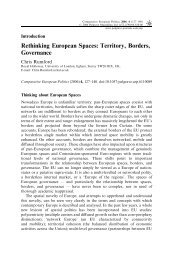Europeanisation, National Identities and Migration ... - europeanization
Europeanisation, National Identities and Migration ... - europeanization
Europeanisation, National Identities and Migration ... - europeanization
Create successful ePaper yourself
Turn your PDF publications into a flip-book with our unique Google optimized e-Paper software.
104 Krystyna Romaniszyn<br />
consumer culture, it does, however, suit the interpretation of the cultural<br />
diversification as well. In the case of Pol<strong>and</strong>, <strong>and</strong> other post-communist countries<br />
the rationality of McDonald’s – as a specific organisational method of human agency<br />
– st<strong>and</strong>s in contrast to the irrationalities of former communist management<br />
strategies, <strong>and</strong> its remnants. Indicators of the implementation of this organisational<br />
model in these countries may be traced in a whole spectrum of economic <strong>and</strong> social<br />
fields such as the housing <strong>and</strong> trade sectors, in the food industry <strong>and</strong> mass tourism.<br />
Secondly, the same rule of dissemination pertains to consumption habits <strong>and</strong><br />
patterns brought in <strong>and</strong> developed by the newcomers. As one author observes:<br />
A pattern of consumption which has its roots among an ethnic group, <strong>and</strong><br />
which helps its members to create a sense of identity, may become partially<br />
adopted by some other groups in the wider society. Chinese, Indian, Greek<br />
<strong>and</strong> Turkish Cypriot restaurants, for instance, have had something of this<br />
pattern in their history in Britain.<br />
(Bocock 1993: 57)<br />
It also happens that the entrepreneurial immigrants who operate, for example, in<br />
the trade or food industry introducing <strong>and</strong> advertising new products or services<br />
may well shape new consumption habits among the indigenous population. This<br />
is, for instance, the case of Vietnamese businessmen opening their restaurants<br />
<strong>and</strong> fast-food kiosks all over Pol<strong>and</strong>, attracting <strong>and</strong> pulling in local clientele, <strong>and</strong> thus<br />
successfully competing with the Polish ethnic businesses. Needless to say, before<br />
the mass immigration of Vietnamese entrepreneurs, Oriental restaurants <strong>and</strong><br />
fast-food kiosks were rare in the country.<br />
Another dimension of the impact of migration on economic culture provides<br />
the diffusion of new consumption patterns acquired by migrants abroad, brought<br />
back upon their return, <strong>and</strong> ‘implemented’ by means of remittances. This time, the<br />
direction of the diffusion goes from the host country into the out-migration region<br />
via the return migrants <strong>and</strong> their families. The imitation in the home region<br />
of consumption patterns obtained abroad reveals a strategy of postponed consumption<br />
as opposed to immediate consumption, occurring in the host country (Romaniszyn<br />
2000b: 140). The former one takes place in the hometown or village upon the<br />
migrants’ return or, in the meantime, by use of the remittances <strong>and</strong> serves to raise<br />
the migrants’ st<strong>and</strong>ard of living, <strong>and</strong> to tighten social relationships due to the sharing<br />
of goods (ibid.). It also sets or adds to the shape of the local st<strong>and</strong>ards of consumption<br />
in the out-migration region which are clear copies or ‘mutations’ of the patterns<br />
perceived in the immigration country. For instance, in Podlasie, which is an outmigration<br />
region in north-eastern Pol<strong>and</strong>, those returning from the Benelux<br />
countries, the destination for local labour migrants, imitate middle-class housing<br />
st<strong>and</strong>ards observed abroad. Heading mostly for Brussels <strong>and</strong> surrounding places<br />
these migrants take up jobs as cleaning ladies (women) <strong>and</strong> construction workers<br />
(men), <strong>and</strong> thus exploit the opportunity to study the patterns of house architecture,<br />
decoration, l<strong>and</strong>scaping, etc. Back in the home they copy those patterns utilising<br />
acquired means. Visible results of the consumption patterns’ diffusion brought about



